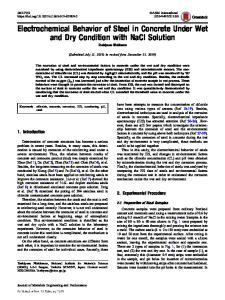Micromechanical Properties of Concrete under Freezing-Thawing Condition
- PDF / 1,455,954 Bytes
- 13 Pages / 612 x 792 pts (letter) Page_size
- 40 Downloads / 409 Views
ISUAL AND MEASUREMENT CONTROL
Micromechanical Properties of Concrete under Freezing-Thawing Condition B. X. Tanga and R. F. Xieb, c, * a
School of Econnomics and Management, Ankang University, Ankang, 725000 China School of Civil Engineering, Nantong Vocational University, Nantong, 226007 China c School of Naval Architecture, Ocean and Civil Engineering, Shanghai Jiao Tong University, Shanghai, 200240 China *e-mail: [email protected] b
Received July 31, 2019; revised December 27, 2019; accepted December 27, 2019
Abstract—The researches on micromechanical properties of concrete subjected to freeze-thaw cycles are few. Under freeze-thaw action, the changes of micromechanical structure and mechanical properties of mortar and interfacial transition zone (ITZ) were characterized by nanoscratch. The volume fraction of micropores increases almost linearly, up to approximate 45%. Moreover, the scratch hardness of different micro-phases in mortar and ITZ decreases gradually with the increase of freeze-thaw cycles, which can be attributed to the increase of micropores. In addition, the thickness of the ITZ gradually increases to 60 um under 1500 F-T cycles, which is consistent with the results using SEM. Keywords: micromechanical properties, nanoscratch, scratch hardness, ITZ DOI: 10.1134/S1061830920060078
1. INTRODUCTION Concrete structures, e.g., road pavement, bridge deck and pier, in north cold regions are often subjected to alternate freezing and thawing which seriously affects the durability of structures. Investigations on the durability of concrete under freeze-thaw (F-T) condition mainly focus on the mechanical properties at macro scales such as stress characteristic, tensile properties, mechanical properties of flexural structure members, and have revealed a reduction in the mechanical resistance [1–4]. As is known to all, concrete has complex compositions at meso scale. Studying the microstructure and micromechanical properties of concrete would be more in-depth understanding of the reduction mechanism of macroscopic performance. Numerous recent papers have attempted to simulate the freezing behavior and to investigate the deterioration of cemented materials at micro scales based on frost damage mechanism [5–8]. Some damage models considering the microstructure of cement-based materials could provide the internal damage assessment. But these models are oversimplified where either hydraulic pressure or crystallization pressure plays a dominant role [5, 9–11]. In addition, the microstructure changes of concrete under F-T action have been studied by means of X-ray diffraction (XRD), scanning electron microscope, ultrasonic imaging, X-ray computed tomography and so on [12–14]. However, the above researches mainly investigate the damage of concrete due to expansion and connectivity of micro pores under hydraulic pressure and crystallization pressure. The micromechanical properties of concrete components are important under F-T condition. The nanoscratch test as a versatile and rapid evaluation method of material mic
Data Loading...











